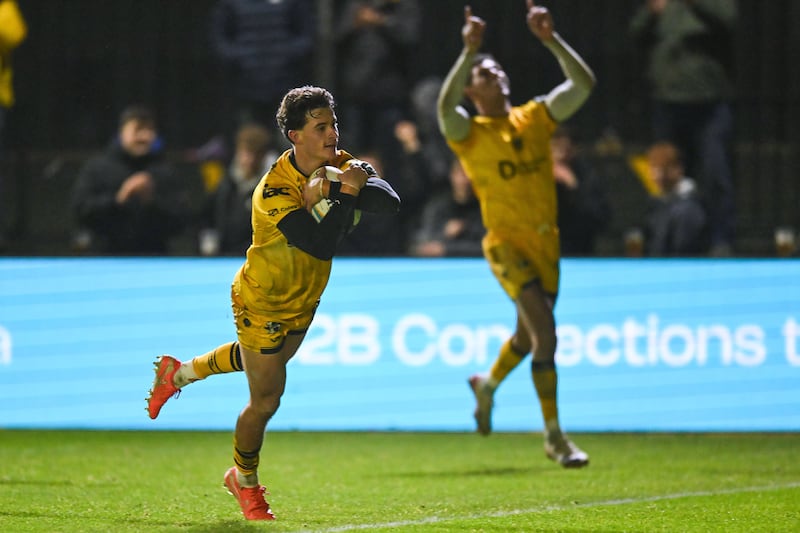"Well, what the f**k are you doing in all that yellow then?" snarls the angriest man in Ikea after I tell him I don't know where the returns department is because I don't actually work for Ikea.
He is carrying a broken light fixture and had approached me as I lounged at the top of the steps leading into the store. I try to explain what I’m doing in the luridly yellow get-up, but he’s having none of it, and as I talk his face turns alarmingly red. “F**king smart-arse,” he shouts before being led away by a softly spoken person who actually does work for Ikea and actually does know where the returns section is.
“What the f**k are you doing in all that yellow then?” I repeat quietly to myself. To be fair to shouty man, it’s a good question.
The minute I arrived I was handed a bag containing a clingy yellow bowling shirt, a heavy yellow V-neck jumper and a pair of unforgiving blue trousers
Ahead of my day working behind the scenes with the flat-pack kings of the world, I was asked for my measurements. The minute I arrived at the store in Ballymun, in north Dublin, on a viciously cold, damp March morning I was handed a bag containing a clingy yellow bowling shirt, a heavy yellow V-neck jumper and a pair of unforgiving blue trousers.
The get-up was to help me better blend in with my coworkers, a word I hear a lot over the course of my day. I change with a heavy heart. A coworker joins me in the locker room. He’s all deep sighs and dark gloom and we dress side by side in grim silence. I make my way to the coworker area, the small office space where Ikea’s admin staff and management are beavering away, although it’s not yet 8am.
It’s like any open-plan office, with a hot-desk area and dedicated workstations allocated to various teams who manage the operation. The only thing distinguishing it from a normal workplace is the fact that everyone is dressed just like me.
Across the hall from the office space is the relaxation space. It’s fitted out like one of the fake rooms found on the shop floor and it’s where staff – sorry, coworkers – go for breaks. There are leather loungers, comfy chairs and a big telly in the dimly lit space. There are also three or four coworkers. One looks suspiciously like he’s asleep.
He is asleep.
Ikea's head of public relations tells me we're starting our day 'with Scott at Comm-In before a visit to logs for replen'. I stare blankly at her
I'm about to give him an urgent nudge while hissing "sketch" when the retail giant's head of public relations, Eleanor Murphy, appears at my shoulder. "Coworkers work long shifts, so it's good to have a place to relax," she says in a soft voice before telling me we're starting our day "with Scott at Comm-In before a visit to logs for replen".
I stare blankly at her. I know she’s using words but I’ve absolutely no idea what those words mean.
Maybe she’s speaking Swedish, I think. There are, after all, loads of meaningless (to me) Swedish phrases and words dotted about the place and I could do a passable impression of the Muppet Show’s chef simply by reading aloud the names attached to the bathroom cabinets.
Sensing my confusion, she translates her sentence into English. It turns out we’re going to meet a man called Scott who is in charge of logistics near the communications and interiors department, after which we will oversee the replenishment of the stock before the store opens.
Scott Fairbairn is Ikea's deputy logistics manager – or DepLogMan maybe – and if he's not an Ikea lifer then he certainly has had his life assembled by Ikea. As a younger man he started work in its Edinburgh store, where he met his wife. They moved to Australia to work for Ikea. They had a child there and moved to Dublin to work for Ikea. They have had a second child here.
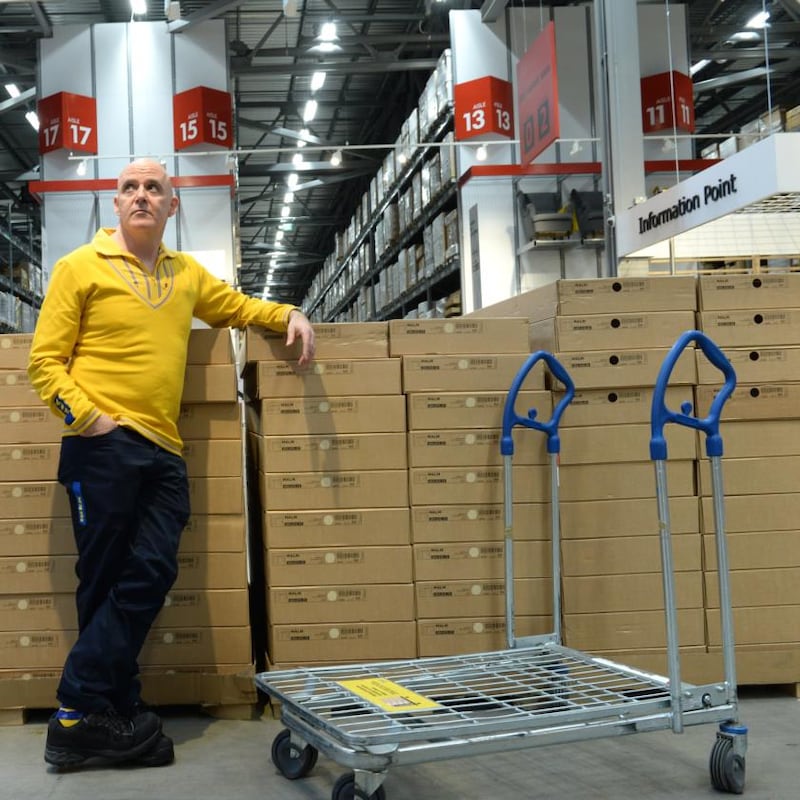
Scott's job is to manage the stock flow from Ikea factories across Europe into Dublin port and then on to the Ballymun shop floor. He is an Ikea Goldilocks, having to make sure Dublin always has exactly the right amount of stuff. If he orders too little, shoppers may be left disappointed. If he orders too much, freight containers full of Ribba frames and Billy bookcases will spend too long in the port.
“When it’s sitting at the docks it’s costing us money, so what we have to do is bring in everything in an even flow,” he tells me. “That helps drive down costs and pass on savings to our shoppers.”
Or make more money for Ikea, maybe.
And, make no mistake, Ikea is good at making money. Its 424 stores in 56 countries generated an operating profit of €2.25 billion in the year to the end of last August. Irish sales reached €181.5 million over the same period.
The biggest sellers are the Kalax and the Malm. And the Ribba frames are massive. Irish people buy more frames than any other country
It makes all these mountains of money despite its deserved reputation for being exceptionally low cost and its equally deserved reputation for causing many of the blazing rows among Irish couples as they struggle to get big cardboard boxes into small cars before trying to assemble what’s in those boxes while staring at sheets of sometimes challenging instructions and a heart-stopping amount of fiddly screws.
It’s not just consumers who have to contend with occasionally baffling diagrams. So do Ikea coworkers. As we walk into the giant self-service warehouse where the flat-pack products live, Scott points to a complex looking map. It’s is the forklift traffic plan. “You have to memorise this so you know what’s happening,” he says. “But you don’t if you stick with me.”
I stick with him. Forklifts whirr across the warehouse piling cardboard boxes high. “If I think I’m going to sell 10 units a day, then I want 50 on the shelves so that the very last customer of the day has the same experience as the first customer,” Scott explains. “I don’t want that last customer to have to bend down to pick up the last unit on the shelves. And we have to get everything in place before the store opens. Once 10am comes, all the forklifts are off the floor.”
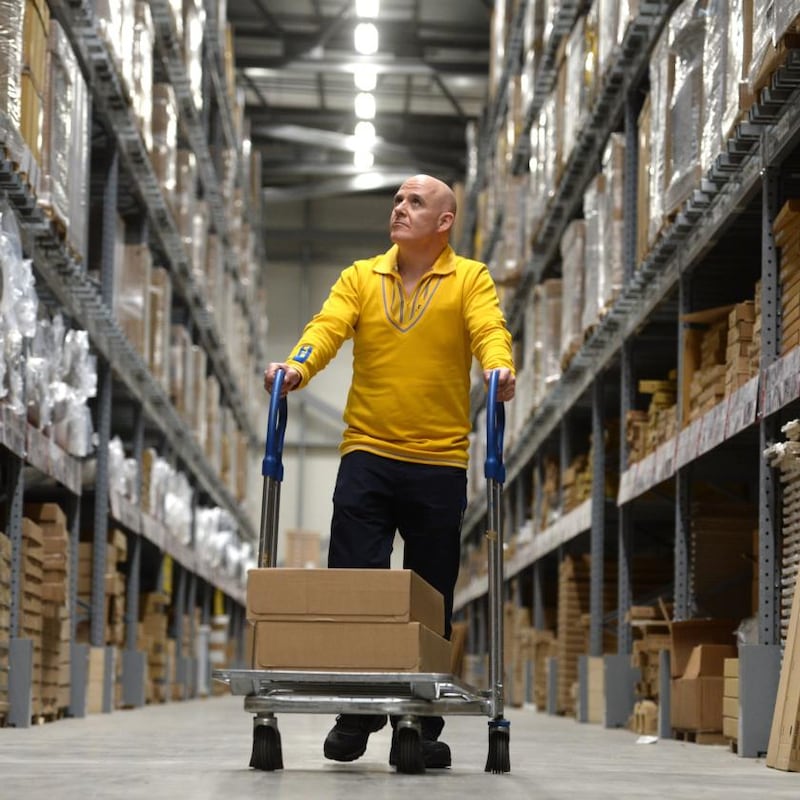
I ask him what Irish people buy most. “The biggest sellers are the Kalax and the Malm,” he says. One is a shelving unit, the other a set of drawers. I have both in my house. “And the Ribba frames are massive,” he says. “Irish people buy more frames than any other country.”
I have them too, I think, saddened by my sheep-like shopping habits.
Ribba. Malm, Kalax. Brimnes. Karlsö. Ikea's product names are actually logical. Ingvar Kamprad, the Ikea founder, who died last year, aged 91, was dyslexic. He found it easier to get his head around names rather than product codes. He devised a system that saw product lines given names he was familiar with. Garden furniture is called after Swedish islands; desks are Swedish men's names; beds are commonly called after places in Norway.
And while we’re on beds, it’s worth noting that, by some estimates, one in 10 babies in Europe are conceived on Ikea beds That is little short of miraculous, given how hard it can be to put those beds together. I ask Scott if he’s any good at assembling flat-pack furniture. “I’m terrible,” he confesses. “My wife does it all. Something that takes me 20 minutes will take her two.”
If you saw this place at 2am you'd have said there was no chance it could be ready in time for opening. There was cardboard everywhere. But we're always ready
We move into the “Market Hall” where smaller products sell. More than two dozen staff have worked through the night to ensure that when the shop opens everything is in order. “If you saw this place at 2am you’d have said there was no chance it could be ready in time for opening,” Fairbairn says. “There was cardboard everywhere. But we’re always ready.”
The public address system comes to life. “Good morning, this is a coworker announcement. The morning huddle will take place in the customer restaurant at 9am.” It is 8.55am so I race to the restaurant as do all the coworkers on duty.
Every morning they gather for a huddle where store news is shared and departmental responsibilities are doled out.
Today, Scott leads the huddle.
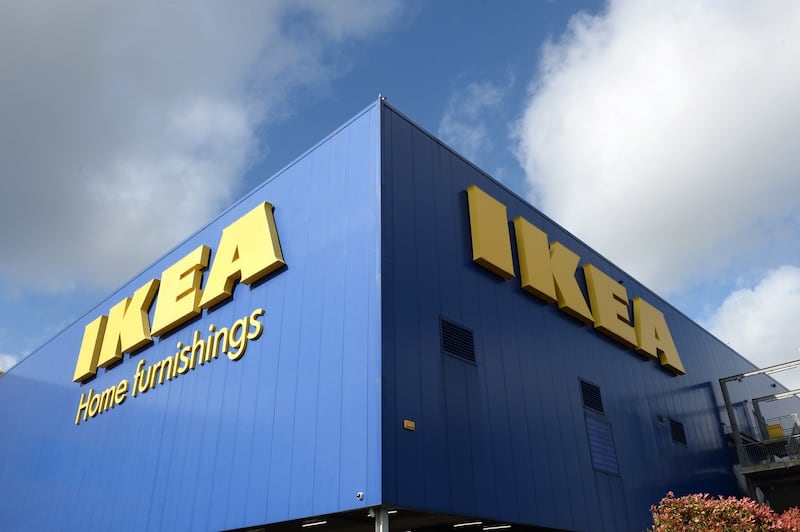
“Yesterday’s sales were on target so well done,” he says. There’s a round of applause and some whoops. I can’t escape the feeling the whoops are for my benefit.
Then I’m sent into “recovery” – but not before an awkward encounter. As I walk to the part of the store near the checkouts where less than perfect products are saved from the scrapheap and the best of bargains are to be found, a woman intercepts me. She is wearing the same uniform as I am and we chat amicably for a few minutes. I ask who she is.
"I am the manager," says Claudia Marshall with a hint of surprised hurt in her voice.
I'd expected to meet her later in my day and had all sorts of interesting questions ready. But my mind has gone blank. So we talk about Brexit and how Ireland loves Ikea – her words – for a couple of minutes before she makes her excuses and leaves.
Hours later she announces that she is moving on from her manager’s role. Was it something I said?
Kreisimir Koevacevic is Ikea's head of recovery. He started working for the shop in Zagreb before transferring here two years ago. His job is "to make sure the stock is in good condition on the shop floor. If it's not, then it comes to us and we'll see what we can do. If we can't repackage a product or if it's slightly scuffed, then we assemble it and it goes to the bargain corner. If it can't be assembled, we use it for spare parts."
He points at a big machine in the corner. It’s the Tornado, a sort of vending machine out of which thousands of spare parts can be summoned. There is a big sign on the vending machine which says “do not enter tornado”. It seems like solid advice.

I ask Kreisimir what kind of discounts are available in the bargain corner and he shuffles awkwardly, concerned he might be revealing commercially sensitive information. To help him out I point to price labels showing discounts of 20 and 30 per cent. He looks relieved. I ask when is the best time for shoppers to visit the bargain corner. “Friday morning because we like to have the bargain corner well-stocked ahead of the weekend rush.”
Good to know.
Ali Sheridan is the store's sustainability leader and as I and Kreisimir chat about cheap rugs, she hovers. Then she tells me that sustainability is in Ikea's DNA "and one of our core beliefs".
While it would be easy to arch a sceptical eyebrow given that for more than 70 years, the retailer has been selling products which many view as disposable, that would be unfair. Ikea is doing a huge amount of work on reducing the footprint it leaves on the planet. It sells only LED lights, pushes water-saving taps and induction hobs and harvests rainwater on its roof. The freezer bags it sells by the truckload are made of sugar cane and there are rugs made from recycled plastic bottles.
“By 2030 we want to be a fully circular retailer,” Ali says. “We want to be in a position to sell products and take them back when they come to the end of their life so that we can reuse them and ensure there is absolutely no waste.”
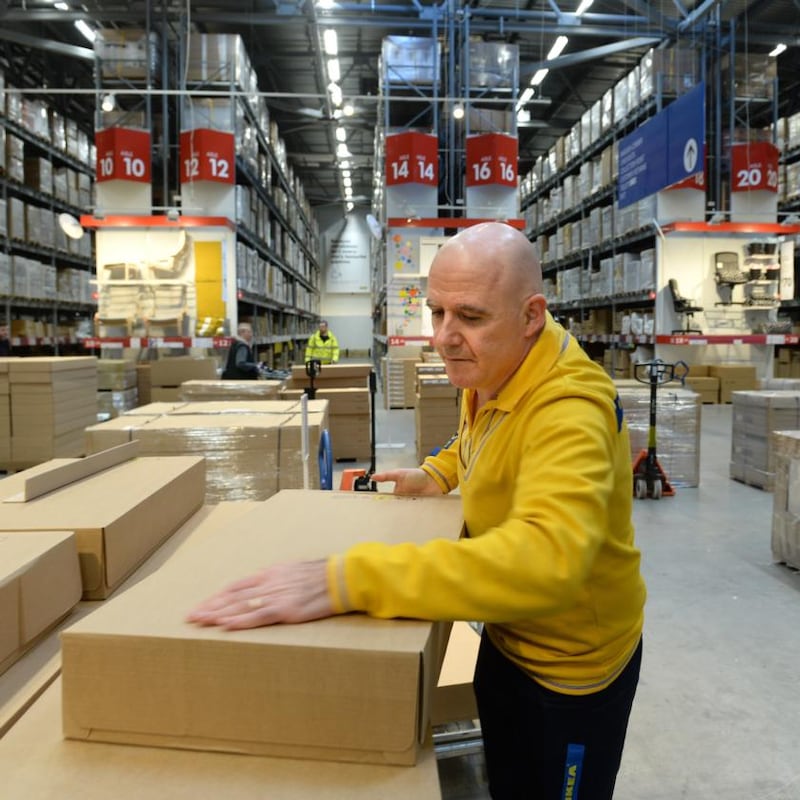
As she talks, Carrie Kinihan is nearby at a machine to cut boxes to size for Ikea products. She's about to unpack what looks like a perfectly fine box only to repack it in a new one.
What’s that about, I wonder.
“People won’t buy something if the box is slightly broken like this is,” she tells me. “Sometimes customers don’t trust the labels on our boxes so they open them to make sure what is inside is the same colour as the label says it is. Then, even if it is the right colour, they still take a new box. I don’t really know why,” she says.
The splendidly named Helly Kelly works as "an internal communication specialist" and seems well suited to the role with her boundless enthusiasm for all things Ikea. As we talk I decide – for my own amusement – to count the number of times she says the word coworkers. After less than a minute, I give up; I can't keep track.
“Sometimes when coworkers are talking to other coworkers about coworkers, the coworkers say their coworkers are sharing news about coworkers,” she doesn’t say. But she may as well have.
She brings me to the coworker restaurant. Each day there is a free healthy meal option. The fruit and salad bowls are free too. And the food that is not free is very cheap. A cooked breakfast costs about €1, while a hot lunch is €1.50.
Outside the restaurant there is a large notice board on which details of the best coworkers are found. The idea is that coworkers nominate other coworkers for the title of coworker of the month. People can be nominated for being super helpful or for working efficiently.
“I was nominated once,” Helly says brightly. “I didn’t win though.”
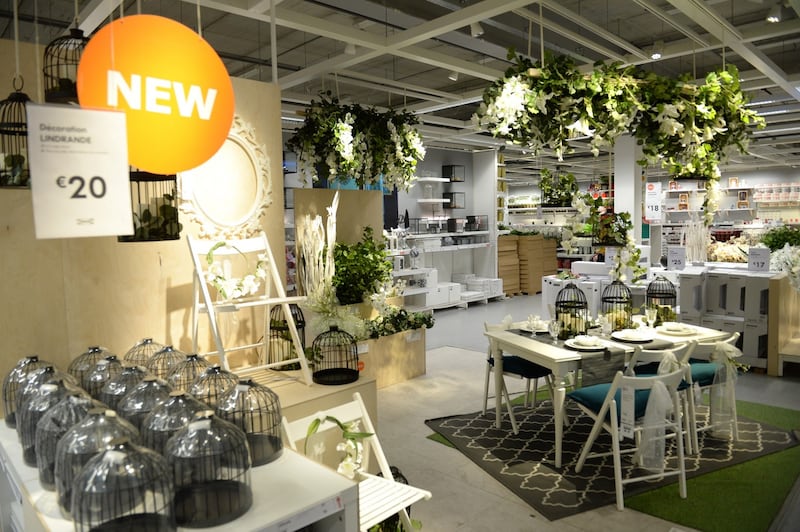
If she had, she'd have been the star turn at a monthly ceremony and then at the end of the year she would have been in the running to win the Irish coworker of the year award and a holiday to Sweden where she could have hung out with other coworkers of the year from other Ikea branches. "That's very exciting," she says.
There is another notice board which hails staff for their vigilance. It sounds more exciting. One coworker is cheered for spotting a shopper swapping €10 labels on to products that cost considerably more than that. The notice says she saved the company €350 “and remained calm throughout. The shopper left with nothing.” Be warned, label swappers, Ikea is on to you.
I’m walked through the rugs and soft furnishings. “Since Game of Thrones, these have been very popular,” Eleanor Murphy says, holding up a sheepskin rug. Why so, I wonder. “They’re the capes worn by the people of the North,” she says. I nod like I know who the people of the North are.
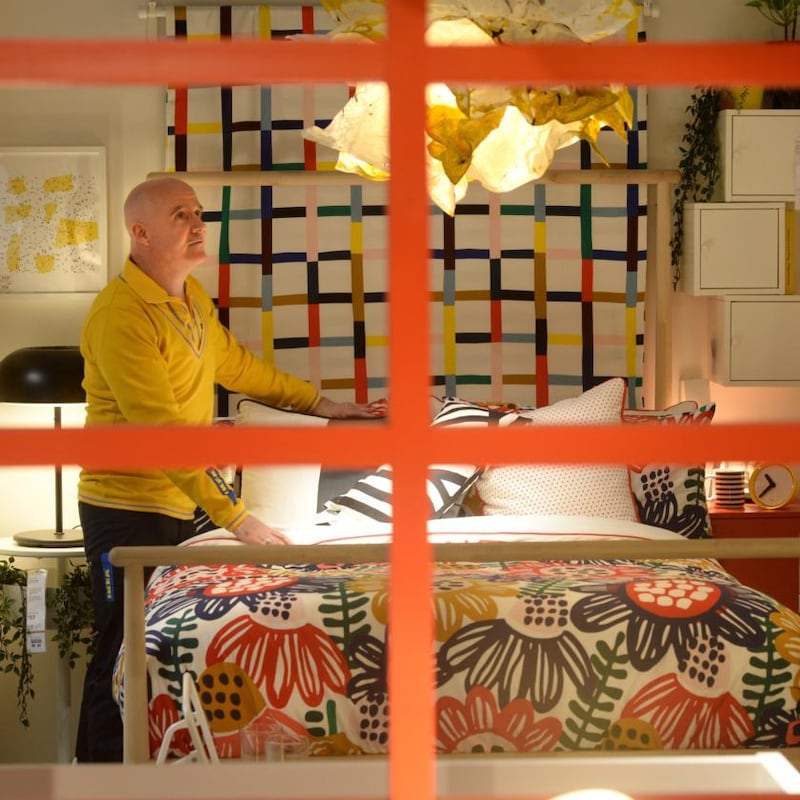
Cassandra McManus is deputy Comm-In manager and her job is to make the store look swish. She assembles the rooms which greet shoppers at the start of their long, long shopping journey. The rooms are known as the First Five and “are a real point of difference for us”, she says.
The First Five are there to show people like me what Ikea products can look like in their natural habitat and how cool our homes and our lives could be if we owned them. I’ve long marvelled at these rooms where everything is perfectly assembled and beautifully hung. It never looks as good when it gets to my house.
On a quiet day the restaurant tills ring up 1,000 transactions, and more than double that on a busy day. That is a whole lot of meatballs
We walk through the house of an imaginary couple with a young baby. It is infuriatingly tidy and free of baby wipes and puke and discarded plastic toys.
We step into a dimly lit room full of black leather and dark soft furnishings. “This looks like a 1970s porn star’s flat,” I say. Cassandra frowns. “It’s actually really popular with millennials.”
Finally it’s time to go to the public restaurant, the biggest in Ireland, which seats more than 500 people. On a quiet day the tills ring up 1,000 transactions, and more than double that on a busy day. If each transaction covers two people, it means about 5,000 people eat here on a typical Saturday or Sunday. That is a whole lot of meatballs.
And then my time is up and as I return to the locker room to purge myself of yellowness, I resolve to remember the shortcuts I’ve glimpsed over the course of my day – there are a whole lot more of them than you know.
But I know that even if I do remember them, which is unlikely, I’ll never use them. I’m too much of an Ikea sheep to take any of the paths less travelled on my routine pilgrimages through this cathedral of consumption. I might miss something if I did.












